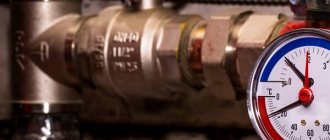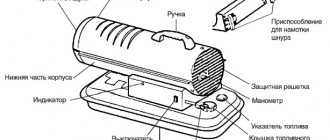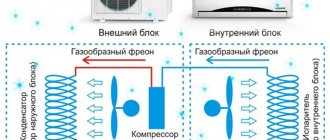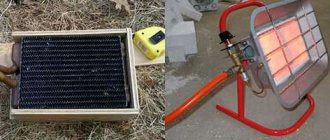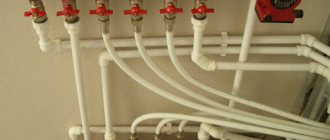Is it possible to heat a garage using IR?
Heating a garage with an infrared heater, wall-mounted or mobile, is not only a rational, but also a profitable solution. The use of IR rays for heating is a distinctive feature of the device. As a result, it is not the air in the room that heats up, but the surface of objects that are close to the installation. A person feels warmth immediately after turning on the device. Using IR emitters, you can warm up both small and spacious rooms.
An infrared gas heater for constant heating of a garage is designed for premises used as automobile workshops. The power of the gas installation is sufficient to obtain the optimal temperature. If you install a programmable thermostat, you can simplify the work process using an automation system and reduce costs by 40%. If you do not need to heat the garage itself, then you can choose spot, local heating with a power of 1 kW.
The main feature is that the emitter closely matches the natural heat coefficient, and the high efficiency can be explained by the fact that there are no heat losses that are observed in other types of heating devices and are spent on heating the air space and heating the pipes. The IR operation process is carried out by gradually heating the environment with secondary heat, which is obtained from the heated surface.
Infrared heater in the garage
LPG heaters
A gas heater for a garage is a stationary convector with a combustion chamber into which gas comes from a cylinder. Combustion products are discharged outside through a coaxial chimney. Air enters the combustion chamber through it.
The gas ceramic heater is equipped with a combustion sensor. It ensures the safety of the device - if the flame goes out, the gas supply will automatically stop.
The thermostat controls the room temperature, periodically turning off the gas air heater to save fuel.
The body of the gas convector heats up to 60 degrees. Not enough to cause a fire, but you can get burned.
A ceramic infrared gas heater converts energy from gas combustion into thermal radiation. It has a limited range and is well suited for heating a small garage.
For example, a ballu gas infrared heater has the following advantages:
- This is a portable gas heater, suitable for use in small spaces.
- Efficiency is close to 100%.
- Safety level: flame control, shutdown when tipping over, exceeding the permissible level of carbon dioxide, cylinder holder.
- Equipped with wheels for easy movement.
- Independence from the power grid.
- The gas cylinder is hidden in the housing.
- Suitable for residential use.
Any gas heater has one drawback - high gas consumption, which is not cheap. To save money, the device must be turned off periodically.
Types of IR heaters for garages
You can install an infrared heater in the garage, operating on gas or electricity, of industrial and domestic type, used as general or local heating.
Industrial infrared heaters
The main direction of operation of the equipment is considered to be heating of rooms with ceiling heights from 3 to 8 m. Ideal for heating garages, car services, and car washes. This device operates on electricity, diesel and gas. There are several types of installations:
- light heaters - their name is due to the fact that the bulb, which is responsible for IR radiation, becomes red-hot at the time of heating. The gas combustion temperature is 800-1000 degrees;
- dark heaters - operate at a temperature of 350-400 degrees. They have a minimal radius of the dangerous heating zone, which is very comfortable in a small room. The minimum safe distance for the radiation source is 2.5-3 m. In addition to the listed characteristics, when choosing industrial equipment you need to pay attention to the characteristics of the radiation. For a garage, it is better to choose wall-mounted infrared heaters using long-frequency radiation.
Household heaters
Infrared heating of residential garages is especially popular. The equipment is used for local heating. Often the emitter is mounted above the hood of the vehicle. Even with a sharp decrease in temperature, the engine will not freeze, so it will be easier to start the car. You can use ceiling-mounted devices to heat the garage, as well as mobile models on tripods as a local or general heating system. Some models are specially produced as ceiling panels that are mounted into the cladding.
If the garage is small and made of iron, then there is no point in installing industrial installations. To obtain the optimal temperature, you need to install two heaters with a power of 1 kW.
Wood-burning garage stove
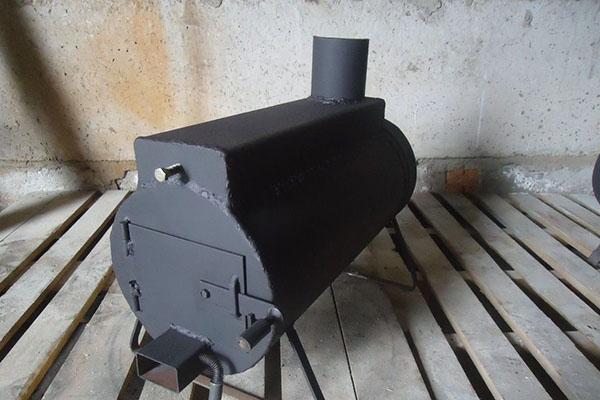
The easiest to manufacture are wood-burning stoves, among which are traditional potbelly stoves and their more advanced modifications - long-burning stoves.
A self-made wood stove for the garage must meet the following requirements:
On this topic:
Dog house heater
Feb 26, 2015
Review of diesel fuel heaters
Feb 25, 2015
BACK FORWARD 1 of 15
- Have small dimensions.
- Have good heat dissipation.
- Effectively burn any wood and its products.
- Be safe to use.
The aesthetics of a garage stove do not matter. That is why the shape of the device is determined by the material available for manufacturing: there is a sheet of metal - the oven will be rectangular; a cylinder or a piece of pipe is used - round. Brick ovens stand apart, the shape and dimensions of which are determined by the brickwork pattern (order).
Potbelly stove: simplicity and efficiency
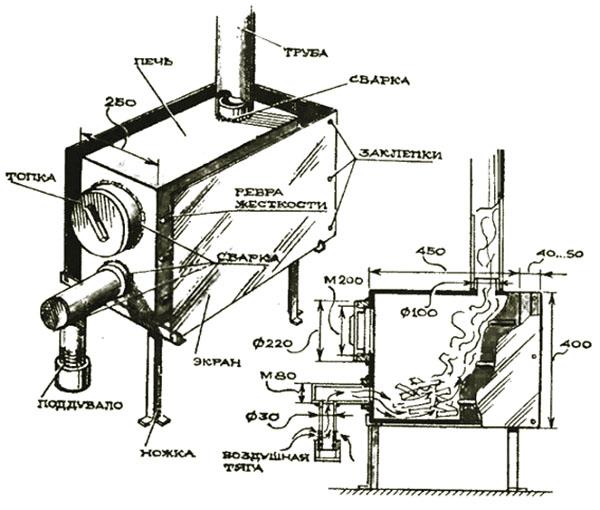
Any car enthusiast who owns a grinder and a welding machine can, without any special financial costs and relatively quickly, make a simple potbelly stove for the garage with his own hands: drawings of various modifications and orientation are presented in large quantities in specialized literature and the Internet.
The classic design of a potbelly stove does not have a grate or an ash pan.
This option is easier to manufacture, but less effective and does not meet fire safety regulations. When cleaning the firebox, a spark from the coals can cause a fire of fuel and fuels and lubricants stored in the room.
For a garage, it is better to use a potbelly stove with an ash drawer.
To increase efficiency, domestic craftsmen equip their modified potbelly stoves with horizontal partitions.
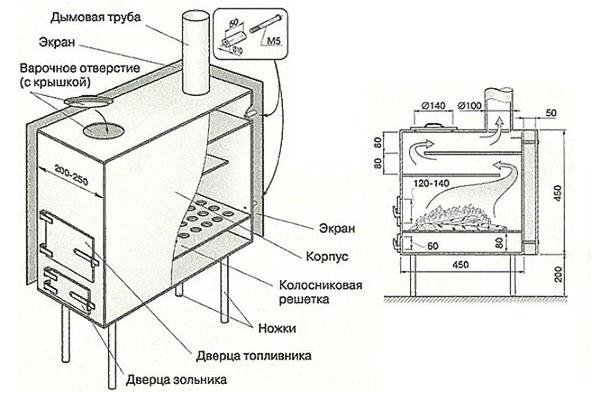
This design forces the hot combustion products to make two turns, rather than “fly out into the chimney.”
Advantages:
- fast heating;
- ease of manufacture;
- versatility in terms of fuel consumption.
Flaws:
- short service life due to rapid burning of the material;
- rapid cooling of the housing.
Long burning stove
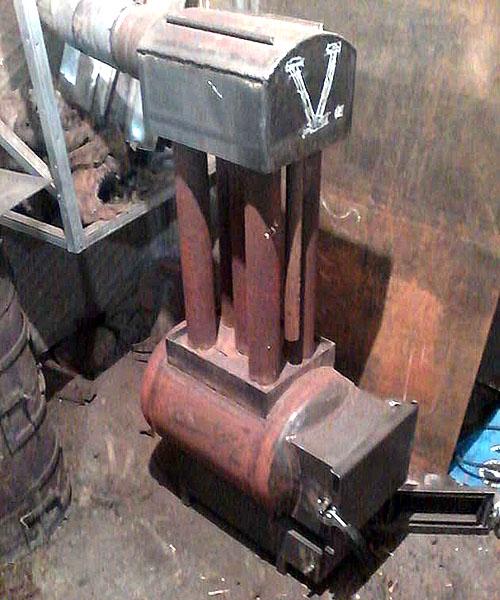
For most car enthusiasts, a long-burning stove for the garage is a godsend. This design allows the device to operate on one tab for a long time.
The operating principle is as follows:
- Fuel occupies the entire volume of the combustion chamber.
- Combustion spreads from above with a deficiency of oxygen, which is supplied very limitedly from the lower part of the installation. This method allows the wood to smolder, releasing flammable pyrolysis gases that burn in the upper part of the combustion chamber.
With a sufficient volume of the combustion chamber (200 l), the stove can operate on one stack for 8 to 24 hours. One of the designs of a self-made long-burning pyrolysis furnace is shown in the photo.
The device is made of a small 24 cylinder installed in a horizontal plane. This element is the fuel chamber in which the thermal effect on wood occurs. A fuel chamber door is provided at the end part; below is an ash pan.
A heat exchanger made of five thick-walled metal pipes is installed in the upper part of the tank. A combustion chamber for pyrolysis gases with a smoke exhaust is located above the heat exchanger.
The approximate power of the furnace does not exceed 5 kW. However, the tests showed the following results: a brick garage with an area of 30 m2 heats up to +20°C in an hour. On one tab the device worked for about 2.5 hours.
How to correctly install infrared heating in a garage?
First you need to understand why you need electric heaters. If you want local heating to create and maintain a temperature of +5 degrees in a room of 20 square meters, then it is better to buy a 1 kW power emitter. The ideal option would be to place it above the hood of the car. The power can be calculated using the formula 50 W = 1 square meter. Main heating is calculated using the formula 100 W = 1 square meter. You need to make an accurate calculation of the heated area in advance.
After this, find out the power of the equipment. To the amount received, add 10% for possible heat loss. If the garage has 20 square meters, then you can install one 2 kW emitter or two 1 kW emitters. The manufacturer separately indicates on the packaging the required distance from the radiation source to the heated parts. This way you can install the equipment correctly. Household devices are mounted at a distance of approximately 1.5-2 m from the vehicle.
Features of water heating in the garage
The difficulty of a warm hangar lies in its inconsistent operation. If the heating is turned off for a long time, the circuit may break due to freezing of water in the pipes.
The main feature of water heating in a room is to warm it up to a temperature of + 5-8 0C. This will provide the necessary warm-up to the car and prevent the development of metal corrosion.
Advice! Filling water heating pipes with antifreeze will prevent rupture of system elements when the garage is not constantly heated.
The scheme includes:
- boiler;
- radiators;
- line for supplying hot water and discharging cooled water.
The boiler's job is to heat the water that moves through the pipes to the heating radiators. The cooled liquid is returned to the boiler in reverse and the circuit is cycled.
Advantages and disadvantages of IR
Garage IR heater equipment, technical indicators and features of use have specific advantages and disadvantages.
- connecting equipment does not require large financial investments;
- the basic package consists of the necessary parts for installation;
- simple connection of an electric emitter;
- installation of gas equipment may require obtaining the necessary permit;
- the possibility of separate zones of the room, rather than the entire garage;
- modern models are protected against overheating of the surface and fire in the event of a fall.
- the power of household appliances is much reduced in order to obtain favorable heating conditions;
- the high cost of the device and the large number of Chinese counterfeits that fill the climate system market.
The IR heating system has no analogues. Compared to a standard heating radiator, they allow you to get instant heating even in a cold building. High efficiency and almost no significant disadvantages explain the popularity of infrared emitters.
There are 2 types of garages. Some are part of a heated house and therefore it is also warm and comfortable to be there. You can even invite your friends there to tinker with your car, set up a workshop, or set up a drum kit. The second ones stand separately from the house and it’s cold there. Very cold. More precisely, in the summer it’s just cool there, but in the winter... In the winter it’s so cold there that you want to quickly warm up your icy car, drive out, close the garage and never return there - or at least until the evening. Common situation? What to do if you spend a lot of time in the garage in the winter - repairing cars yourself? A garage heater can be your salvation.
But before we present you with the top five models, let's understand: What types of heaters are popular among homeowners? What are the differences in the power supply of heaters? How to calculate the required power and choose the best one to heat your garage?
Liquid fuel heating stoves
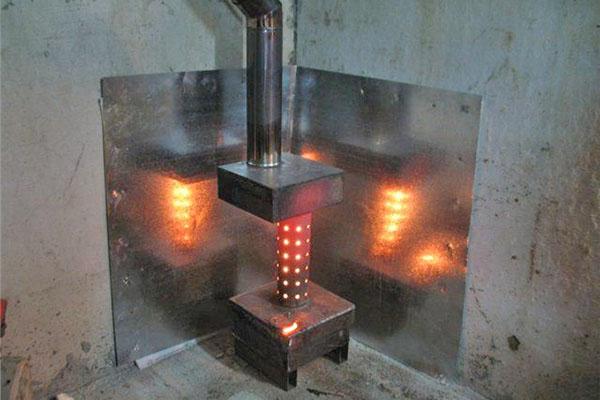
Liquid fuel stoves for heating garages are very popular among domestic car owners. The main types of fuel for such heaters are diesel fuel and waste, which are in the arsenal of most garage owners.
Advantages of liquid fuel heaters:
- high efficiency with small overall dimensions;
- the ability to work on almost any liquid fuel, provided that it does not contain moisture.
Flaws:
- fire hazard;
- high fuel consumption;
- high concentration of combustion products in the air.
On this topic:
Heating system installation
Choosing a circulation pump for heating a summer house
Install a ceramic tandoor stove at your dacha
Infrared heaters: types and selection rules
BACK FORWARD 1 of 9
Let's consider the design features of test heaters and homemade diesel heaters.
Heaters under development
It is very simple to assemble an effective, working furnace for the garage with your own hands, because it consists of only three elements:
- The lower container, which serves as the primary combustion chamber.
- The upper tank in which combustion of flammable gases formed during heating of the fuel occurs.
- The afterburner is a perforated tube connecting the lower container and the upper tank. Through the holes, air enters this element, which mixes with flammable gases and enhances their combustion.
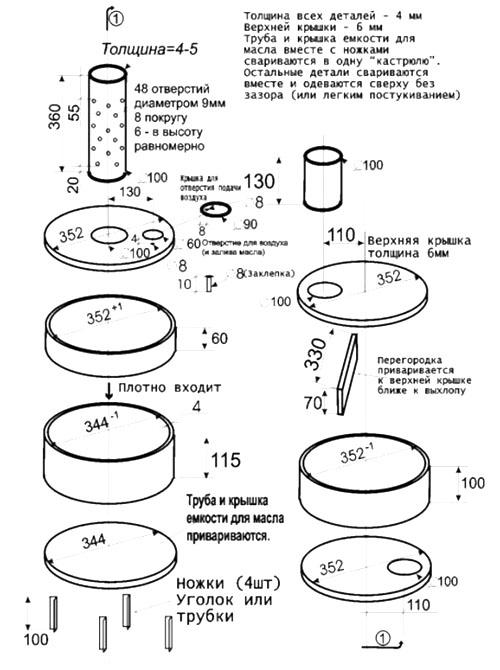
The drawing shows in detail all the elements of the furnace and the order of their assembly.
Diesel stoves
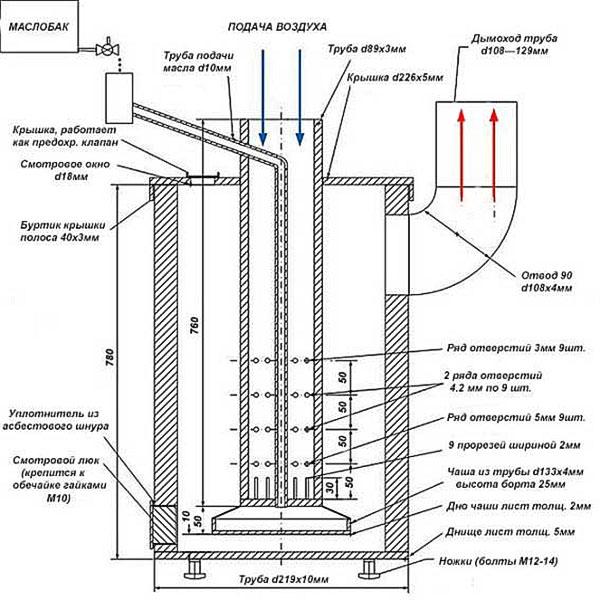
Diesel stoves for the garage can be purchased or made by yourself. Ready-made models will cost the car owner more, but will significantly save time on manufacturing the unit. To create such a heater yourself, a dropper stove is ideal, the drawing of which is presented below.
The dropper design consists of the following elements:
- a bowl installed inside a steel pipe;
- a tube for metered fuel supply is installed on top of the bowl;
- An air pipe with holes (afterburner) is mounted in the center of the pipe.
The principle of operation of such a furnace is simple: fuel drops into a heated bowl, where it instantly burns, releasing thermal energy and some of the pyrolysis gas, which mixes with air and burns in an afterburner. Fuel is supplied by gravity or by means of a valve installed in the fuel line gap outside the installation housing.
Design advantages:
- relative safety of operation;
- high efficiency.
Flaws:
- the need to arrange a chimney and provide draft through high-quality supply ventilation;
- the smell of combustion products while the stove was in operating mode.
You should know that the “dropper” works very successfully, both on diesel fuel and on any types of engine oil and waste.
Heater for the garage: the most frequently asked questions
Which heater is best?
The most popular garage heaters are fan heaters and infrared heaters. Both types can operate either on electricity or on propane (less commonly natural gas). Electric ones are usually more expensive to operate, but they are popularly considered safer, while propane ones are cheaper, but require stricter compliance with safety rules and the constant availability of gas cylinders.
Fan heaters drive large volumes of air through heating elements - and the hot air quickly fills the entire air space of the room.
Infrared devices use the principle of soft radiant heating; they heat not the air, but the walls, floor, ceiling and objects in the room, which then release heat to the air. Therefore, it is recommended to place such devices not too high and far from you, otherwise you may not feel the heat.
Which heater should I choose for my garage?
When choosing a heater, the main thing is the area of the room. It is irrational to use a heater that is too powerful for a small garage or to try to heat a large workshop with a small portable heater. In small rooms, it is enough to install infrared heaters: their power is less than that of a fan heater, but it is enough to heat such a space. In addition, they begin to heat up faster.
For a large garage, it is wise to acquire a powerful fan heater that can maintain an optimal microclimate for a long time even in the iciest room.
What are the most economical garage heaters?
Thermal output of heaters is measured in BTU/hour (propane models) and Watts (electric models). The higher these indicators, the more area the device can heat. Having decided to purchase an electric heater, calculate how many watts you will need to heat the room: to do this, multiply its area by 8 and round. We emphasize: this is an approximate result, since a lot depends on the climate zone, ceiling height, etc.
For a small garage, a heater with a power of 1000-1500 W is enough (5000 BTU/h for propane models), and medium-sized garages need a heating power of 2500 W. Large garages and workshops require much more heat - so aim for devices marked “commercial” from 5000 W (or from 17000-18000 BTU/h and more).
In this Guide, we have collected the 5 best models of propane and electric garage heaters that the modern market offers for rooms of different sizes. There is no longer any need to guess what is the best way to heat your garage: all you need is to know its area and choose the preferred fuel to operate the device. In our review you will find 3 electric and 2 propane heaters.
The best heating boilers
When the issue of choosing an energy carrier has been resolved, it is necessary to decide on the type of heating boiler. It must be economical, easy to use, and have high efficiency. Depending on the heat source, you can choose:
- Gas. The ideal option is a condensing boiler equipped with automatic control. In addition to the cost of fuel itself, you can also save money due to the boiler’s ability to operate at low pressure. In the heat exchanger of the unit, water transitions from steam to liquid, which leads to the release of heat. Thanks to this principle of operation, the boiler is 15% more economical than gas models of other types. You can also install a wall-mounted gas boiler, which provides power modulation.
- Solid fuel. It is best to buy pyrolysis. The operating principle of the unit is based on the effect of high temperatures on wood, as a result of which it decomposes into pyrolysis gas and dry residue. Gas is burned. For the boiler to operate, a buffer tank is needed; it accumulates heat. Of all the solid fuel models, pyrolysis ones are the most economical, but there is a caveat: in the absence of wood, coal cannot be used for heating.
- Electrical. If you need to efficiently heat a room and prevent overloads in the electrical network, it is better to choose a boiler with six heaters and thyristor control. Thanks to the features of the device, you can limit power and save money; an additional plus is silent operation. There is only one minus, but it is significant: heating with electricity is always expensive, because... electricity is the most expensive source of heat.
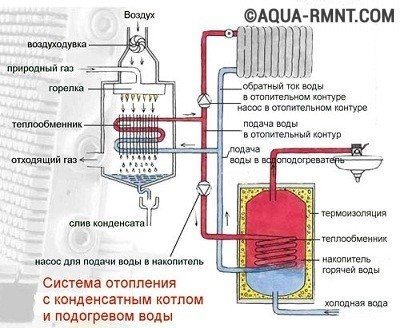
The cheapest heating for a garage is a gas condensing boiler; other types of units may be more affordable and convenient, but they are all more expensive to operate
Choosing an electric heater for the garage: 3 best models
Does your garage have an outlet? In this case, it may be more convenient for you to use electric models for heating. They can no longer be called portable, but they are considered safer. They are beneficial to use if you are not bothered by the fact that electricity will cost you more money than usual - or for temporary use in the “turn it on for a few hours, turn it off” mode. This top includes both a heater for a small garage and 2 models for larger spaces - domestic and commercial appliances.
Gas heaters
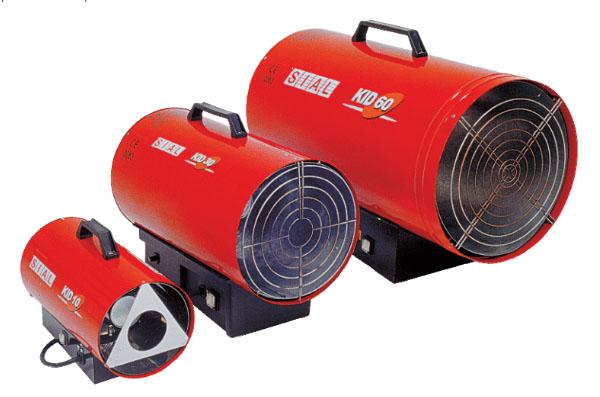
Gas furnaces are often used to heat garages in winter.
On sale, gas heaters are presented in three types of devices:
- IR heater with ceramic burner. Such devices do not require a combustion product removal system.
- Convection type units with a closed combustion chamber. Requires a chimney.
- Heat gun. Ideal for short-term heating of a room.
Today, on the modern market of climate control equipment, catalytic models of gas heaters that operate on the principle of gas oxidation with oxygen are widely represented. The only disadvantages are the high cost of the equipment and the need to install a fire alarm system.
You can make a gas stove for your garage with your own hands; fortunately, there are a huge number of diagrams and instructions for creating one yourself. It should be understood that any mistake in the manufacture of such a unit can lead to a gas explosion, fire, property damage and human casualties, so it is better not to take risks and purchase a finished product from a reputable manufacturer.
Choosing a propane heater for the garage: 2 best models
Household appliances powered by propane have been part of modern life for quite some time now, so propane heaters will no longer surprise anyone. They have 2 main advantages:
- can heat even a very large room
- use cheap gas fuel
Can I use a propane heater in my garage? Yes, thanks to the function built into each presented model, in which the heater will turn off itself when there is a danger of fire or the pressure in the gas cylinder decreases. When propane burns, a lot of heat is released and it can heat both a small and a very large room.
From a wide range of propane heating appliances, we have identified 2 of the most popular models. The first is for heating a small garage, and the second is a powerful heat gun for a large garage or industrial premises.
Gas heater Kovea KH-0203 Little Sun
A small room can be heated using the compact gas heater Kovea KH-0203 Little Sun. This model can be used not only in workshops, garages or in the country, but also taken with you on a hike. And don't be afraid for your safety. The manufacturer has used several innovative technologies in this device that guarantee high functionality and safety during operation.
To light the heater, use piezo ignition. In a few minutes, air in a room of up to 15 square meters. m. will become comfortable and warm. Please note that in order to save money, you should first warm up the room at maximum power, and then reduce the power and switch it to an economical operating mode. With this approach, one collet gas cylinder will be enough for you for several nights. Well, as additional options, we can note the presence of an overpressure valve and a safe ceramic emitter. If the gas cylinder exceeds the permissible pressure level, the gas supply will stop. Gas heater Kovea KH-0203 Little Sun is an excellent alternative to gasoline burners.
Review from a real buyer Works great in medium mode! I heated the garage last winter and it was warm. I'm going to use it this year too!
Mobile gas heat generator Ballu-Biemmedue Arcotherm GP 30A C
Portable, with a powerful fan, a long hose for connecting to a gas cylinder, has an auto shut-off and a 1-year warranty - an excellent solution for the garage.
This model promises to heat up to 1100 m3 with a maximum power of 31.4 kW. When working with a standard gas cylinder, this will last for 14 hours. And this is just one of the variations of the model - others can do even more! There is an option even for owners of large industrial premises and workshops.
Ballu-Biemmedue is valued for its safety, simplicity and speed of operation. It is noted that for him, heating a garage for 2 cars is a matter of several minutes. Usually 10 minutes on high settings are enough to heat any room - and then you can turn it down to a minimum or turn it off completely. Convenient, reliable - maybe this is just what your garage needs?
The better to heat or the choice of energy carrier
In 99% of cases, garage buildings are not connected to centralized heating networks or main gas, so owners have to choose autonomous heating methods. To heat a garage, you can use 4 groups of energy carriers:
- various types of solid fuel - firewood, coal, briquettes, agricultural and other combustible waste;
- diesel fuel, waste oil;
- electricity;
- liquefied gas in cylinders.
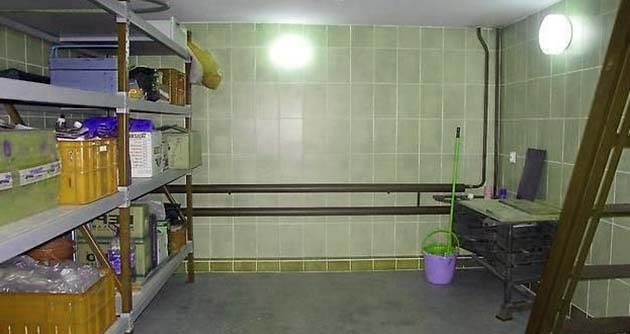
Advice. When you start choosing an option for heating your garage in winter, keep in mind an important rule: the more expensive the energy source, the easier and cheaper it is to organize heating that is convenient to use. Conversely, cheap or free fuel in the form of waste and garbage will bring a lot of trouble - labor costs and initial financial investments.
Solid fuel combustion
Wood and various waste are the cheapest fuel for heating, and in some cases it is available completely free of charge. In the southern regions, which are not rich in forests, another type of fuel is widely used - small agro-industrial waste.
For reference. Agricultural waste consists of small particles sifted from grain crops. These are pieces of stems, weeds chopped by a combine, straw and other waste. The energy price is very attractive and starts from 20 USD. e. for 1 ton.

We recommend: Connection diagram for a gas boiler to the heating system: connecting a double-circuit and single-circuit boiler with your own hands, how to connect the heating, how to connect it yourself correctly
If you decide to heat your garage with solid fuel in the winter, get ready to deal with the following issues:
- purchase or manufacture of a furnace (ideally a boiler);
- chimney installation;
- storage of firewood, coal or waste;
- labor costs for preparation, combustion and soot removal.
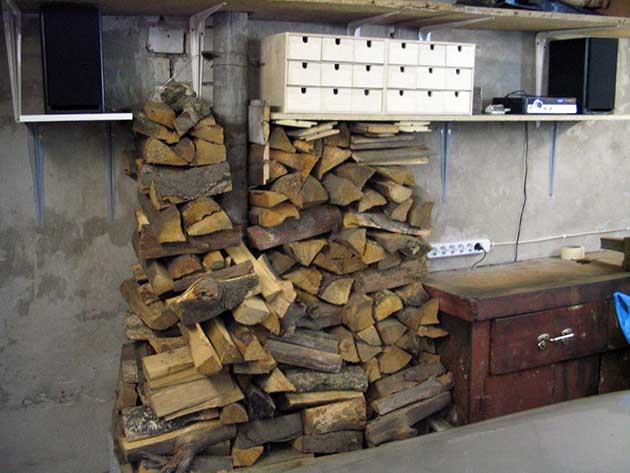
Storing firewood in the garage is not a very convenient solution
The gain is in money and excellent heating of a room of any size, the losing points are listed above. Add here the time for kindling and warming up (0.5-1 hour). Hence the conclusion: cheap heating with solid fuel is suitable for owners of garages and boxes who stay there for 4-6 hours or more every day.
Potbelly stove for heating a garage
Potbelly stoves are the most primitive stoves that began to be actively used at the beginning of the last century. Then their popularity sharply decreased due to the spread of centralized heating. However, potbelly stoves are still used, because they are practically the cheapest way to heat a garage.
The potbelly stove is made of metal. The largest part is occupied by the chamber into which the fuel is thrown. The room warms up due to the contact of the stove walls with the surrounding air. Not the least important role is played by the pipe, which also accumulates heat. To prevent heated combustion products from immediately flying out into the street, a pipe of a clearly defined diameter is used, due to which the warm gases make several revolutions in the vertical plane. This allows you to make maximum use of the heat of combustion of the fuel (efficiency reaches 60-80%) and effectively suck in the air necessary for the fuel to burn completely. The diameter of the pipe in mm should be 2.7 times greater than the volume of the stove in liters.
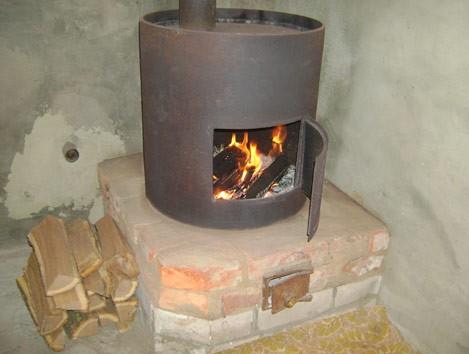
It is important that the chimney has a complex shape: first there is a vertical insulated part, then a horizontal or inclined part, the so-called. hog, which provides up to a quarter of the heat received, because the flue gases burn out here. Potbelly stoves are sold ready-made: there are both the simplest and most primitive options, as well as sophisticated designer ones. If you have the skills, you can assemble a potbelly stove yourself from a barrel or sheet metal.
Advantages:
- a potbelly stove can be heated with any solid fuel, but wood is usually used;
- low price and low cost of operation;
- relatively high efficiency;
- allows you to quickly warm up the room and dry the air in it;
- There are models that can also be used as a stove. They will come in handy for those who spend even too much time in the garage.
Minuses:
- the need for constant monitoring of work;
- high fire danger;
- Suitable for small spaces only;
- the air cools quickly;
- it will be impossible to get rid of the specific smell;
- the need for regular chimney cleaning.
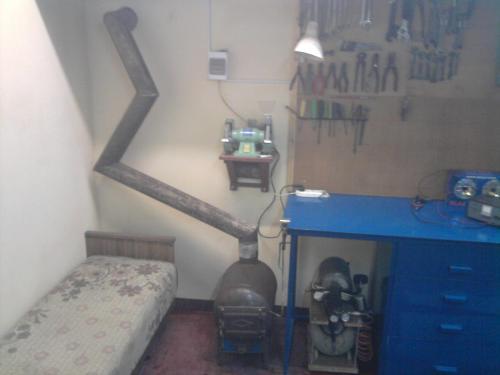
Solid fuel boiler
This is a more expensive, but at the same time, safer and more effective solution. The principle of operation is simple: fuel is burned in the firebox, a container with coolant is heated, which is supplied through pipes and radiators. improved types of boilers are increasingly used
- a pyrolysis boiler has two combustion chambers, in the first the firewood smolderes at a high temperature due to the fact that the amount of air is insufficient. The combustion product is pyrolysis gas, which is burned in the second chamber, releasing much more heat than just wood. The boiler efficiency increases to 90%, and one portion of firewood lasts for 10-13 hours;
- Pellet boilers are fired using pellets obtained from wood waste. They are placed in a bunker, from where they are fed into the firebox in doses. The boiler efficiency reaches 95%; fuel can be loaded once every few days.
The body of solid fuel boilers is made of cast iron or steel. Pyrolysis and pellet boilers are, of course, very convenient, but they are expensive. If funds allow, you can afford such a purchase - it will soon pay off
.
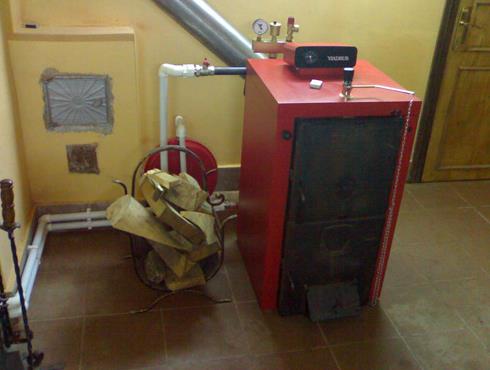
Brick oven
Building a brick oven in a garage is a long, expensive and painstaking task. The fuel for such a stove is usually wood, but coal can also be used. The principle of obtaining heat is still the same. The fuel burns, heats the walls of the stove, and they heat the air. A good option for small spaces. Brick takes longer to warm up than metal, but it also cools more slowly.
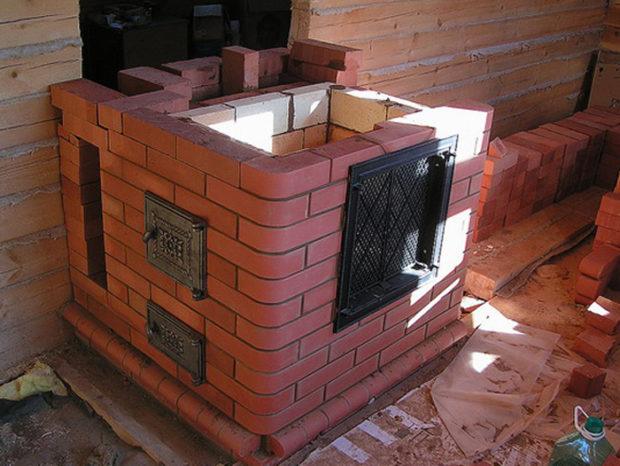
Stove Buleryan
The Buleryan stove is often confused with a potbelly stove and a regular wood-burning stove. She actually absorbed a little bit of both. The operating principle is based on convection. The design assumes the presence of pipes at the base of the furnace and in the upper part. Cold air enters through the bottom of the stove, receives heat from the chamber where the fuel is burned, and exits, already heated, through the top. The pipes are 2/3 soldered into the furnace body to ensure maximum heat transfer. The special design of the firebox and chimney allows you to extract maximum heat from fuel combustion. The presence of a chamber for pyrolysis combustion of fuel plays a significant role here. Combustion products are removed through the chimney.
Advantages:
- rapid heating of the room due to convection and heat transfer from the surface of the stove;
- compactness;
- there is no need to frequently add firewood;
- higher safety compared to a potbelly stove.
Minuses:
- price;
- complexity of chimney installation;
- the need for frequent cleaning of soot.
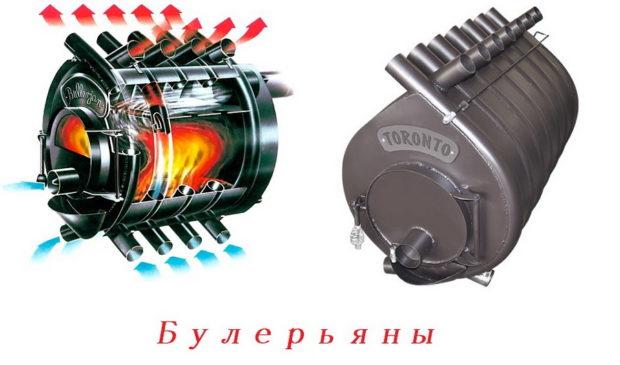
Use of mining and diesel fuel
Heating a box or garage with diesel fuel purchased at a gas station is expensive and extremely unprofitable. An exceptional option is to heat a small area of the room where work is being done using a portable heater, whose characteristics are described in a separate material.
Waste oil is a more financially economical energy carrier, although not the cheapest. This option can be seriously considered when used oils can be obtained at a reduced price. What are the features and pitfalls here:
- Homemade potbelly stoves are used to burn liquid fuel in various types of mines. The safest is a drip stove, which you can order from craftsmen or do it yourself.
- A chimney installation is required.

Drip-type exhaust boiler with forced air supply - Oil containers take up less space than firewood. They are usually placed in the basement.
- The workings need to be settled and filtered.
- The inevitable companions of liquid fuel heating are smell and dirt, although this is not critical for a garage.
- Homemade waste oil stoves are considered a fire hazard.
Note. Due to their cheapness and simplicity, the oil miracle stoves shown in the photo have become especially popular. They tend to shoot flames when the fuel contains a small amount of water or antifreeze, causing a fire.
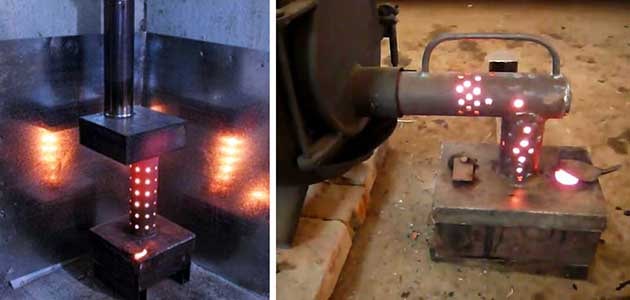
The advantages of using mining are high heat transfer, quick ignition and warming up of the garage box, ease of use (it’s easier to add oil than to chop and carry wood). The conclusion is this: if fuel is inexpensive, or you spend a little time in the garage, then liquid fuel is a suitable option. The initial investment is comparable to wood heating.
When using diesel fuel, it is worth considering the option of a factory-made diesel air heater of the “Planar” type, shown in the photo. With a fuel consumption of 250 ml in 1 hour, the unit develops heat transfer of up to 2 kW. There are also more powerful heaters - 3 and 4 kW with diesel consumption of 0.37 and 0.5 l/h, respectively. Price – within 330 USD. e.
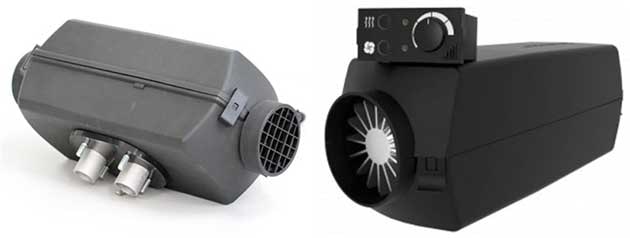
Autonomous diesel-powered air heaters designed for cars
Electrical heating
Heating with electricity is the most comfortable and cheapest option in terms of initial investment. But during operation you will have to pay the full tariff - it makes no sense to install a two-zone meter, you are not going to work in the garage at night.
Let's list all the advantages of electric heating:
- Heating with electricity is convenient and safe. There is no dust, dirt or odors, no need to carry firewood or barrels of fuel.
- There is a wide selection of different air-type electric heaters on sale: convectors, oil radiators, infrared panels and heat guns.
- You can make a water heating system with an electric boiler (if the power limit allows).
- Heating of the garage begins immediately after turning on the heater; a comfortable temperature for work is reached in just half an hour (again, when there is enough power).

An inexpensive portable fan heater can heat only part of the room where work is being done
There are only two disadvantages, but they are critical: the price of electricity and the limitation of the power consumption limit, which does not allow installing an effective heat source. For example, if the contract with the management company specifies a figure of 3 kW, then a convector with only 2 kW is installed, which is not capable of properly heating the garage in the winter.
For reference. Sometimes car enthusiasts use homemade “goats” and fan heaters in the pits, despite the restrictions. Why you can’t do this: there is a danger of the wiring catching fire, the neighbors’ voltage drops, and if employees check the electrical networks, you will face a large fine or shutdown.
Electric heating is an option for short stays in the garage. They came, turned on the heater, completed the intended work in 1-2 hours, turned off the heating and left. If you turned the room into a workshop where you spend your working hours, you will have to pay significant amounts for energy consumption.
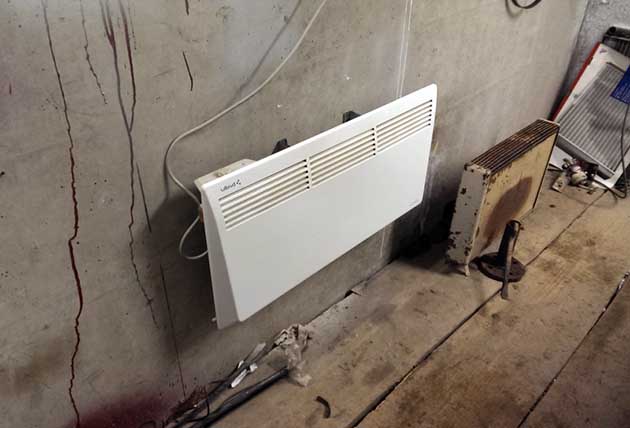
A standard wall convector heats the air in the room much slower than a fan heater
Gas heating
This method of heating a vehicle storage space is acceptable for residents of the Russian Federation, where the retail price of liquefied gas is quite low. It will be too expensive for Ukrainians to heat their garages with propane.
Autonomous heating from gas cylinders is as safe and comfortable as electric heating. Moreover, in the Russian Federation the cost of energy is lower. But there are a number of pitfalls here:
- you need to place the propane tank somewhere so it doesn’t interfere with your work;
- you will have to periodically take the tank to refuel;
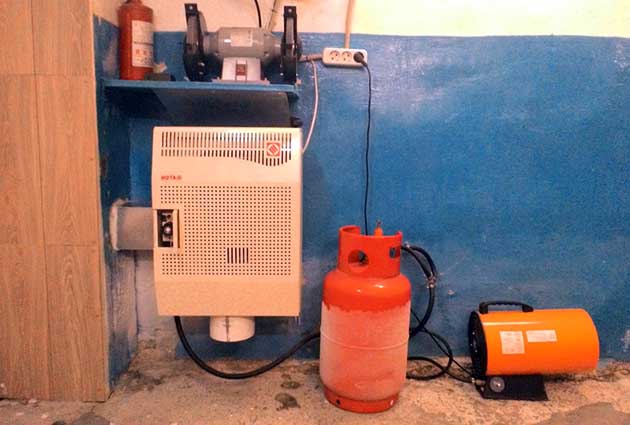
During operation, the tank freezes over, causing the gas supply to deteriorate. - To burn propane, you need factory-made equipment; making gas burners yourself is strictly not recommended;
- you will need a chimney pipe to the street.
If you add up the financial costs, the problems of organizing such heating and refueling cylinders, then the negative aspects will cover up some of the positive aspects of ease of use.
Watch this video on YouTube
A comparison of the cost of 1 kW of heat obtained from various energy sources in Russia and Ukraine is published on this page.

